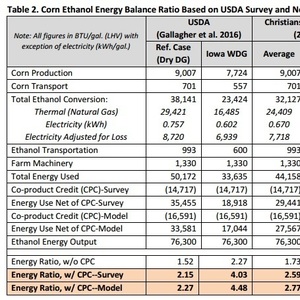RFA analysis finds improvement of corn ethanol net energy balance

Renewable Fuels Association
March 7, 2016
BY Renewable Fuels Association
An analysis conducted by the Renewable Fuels Association and released March 7 finds the net energy balance of corn-based ethanol at U.S. dry mill biorefineries averages 2.6–2.8, an improvement over previous estimates, reflecting efficiency gains.
The figures build on USDA’s recent findings of a 2.1–2.3 net energy balance. RFA’s own analysis uses more current dry mill energy use data than the recent USDA study, which explains why the RFA results are approximately one-third higher than USDA’s findings.
The net energy balance is a ratio of how much energy is required to produce the corn and ethanol, and then transport the fuel to end users. In simple terms, a ratio of 2.8, for example, means every BTU of energy invested in the process to make and deliver ethanol results in 2.8 BTUs of available energy to the end user.
Advertisement
Advertisement
In February, USDA issued its updated net energy balance report on corn-based ethanol, finding “[t]here has been a large improvement in energy balance since 1995, and a small but positive improvement since 2008.” The previous USDA report, conducted in 2010, was based on 2008-era data and found that the balance was 1.9–2.3. RFA’s analysis found that USDA used the same 2008-era dry mill energy use estimates for both its 2010 and 2016 reports.
According to RFA’s own analysis, “[t]he energy balance of the top-performing quartile of biorefineries is in the range of 3.2–3.4, which approaches the USDA estimate of 4.0 for an ideally situated dry mill producing wet distillers grains.”
“As this new analysis shows, the U.S. ethanol industry has made tremendous efficiency gains in recent years,” said RFA President and CEO Bob Dinneen. “EPA should take note and update its lifecycle greenhouse gas modeling of corn-based ethanol under the renewable fuel standard to reflect these improvements. Today’s ethanol plants are achieving the levels of efficiency that EPA assumed wouldn’t occur until 2022.”
Advertisement
Advertisement
The RFA analysis used dry mill energy use data from two other widely respected findings to support its results — Mueller & Kwik (2013) and Christianson & Associates (2016).
To view a copy of the RFA analysis, visit here.
Related Stories
The U.S. EPA on July 8 hosted virtual public hearing to gather input on the agency’s recently released proposed rule to set 2026 and 2027 RFS RVOs. Members of the biofuel industry were among those to offer testimony during the event.
The USDA’s Risk Management Agency is implementing multiple changes to the Camelina pilot insurance program for the 2026 and succeeding crop years. The changes will expand coverage options and provide greater flexibility for producers.
EcoCeres Inc. has signed a multi-year agreement to supply British Airways with sustainable aviation fuel (SAF). The fuel will be produced from 100% waste-based biomass feedstock, such as used cooking oil (UCO).
President Trump on July 4 signed the “One Big Beautiful Bill Act.” The legislation extends and updates the 45Z credit and revives a tax credit benefiting small biodiesel producers but repeals several other bioenergy-related tax incentives.
CARB on June 27 announced amendments to the state’s LCFS regulations will take effect beginning on July 1. The amended regulations were approved by the agency in November 2024, but implementation was delayed due to regulatory clarity issues.
Upcoming Events










